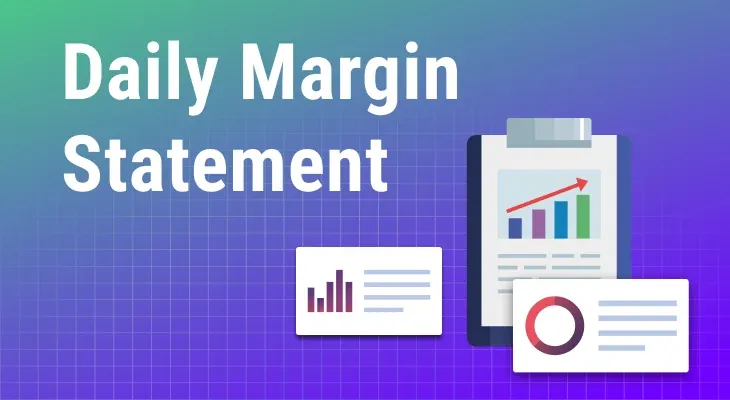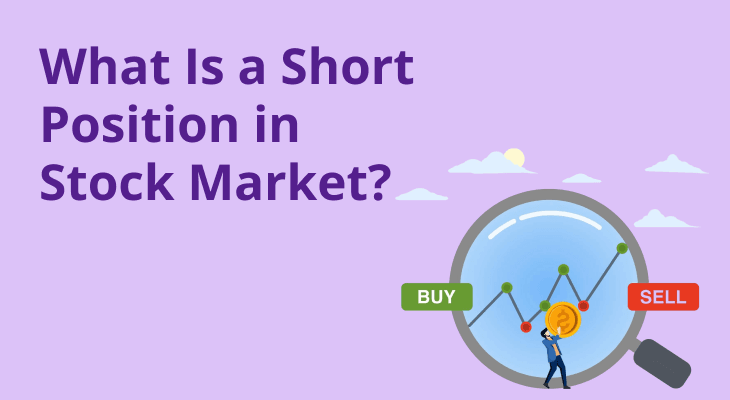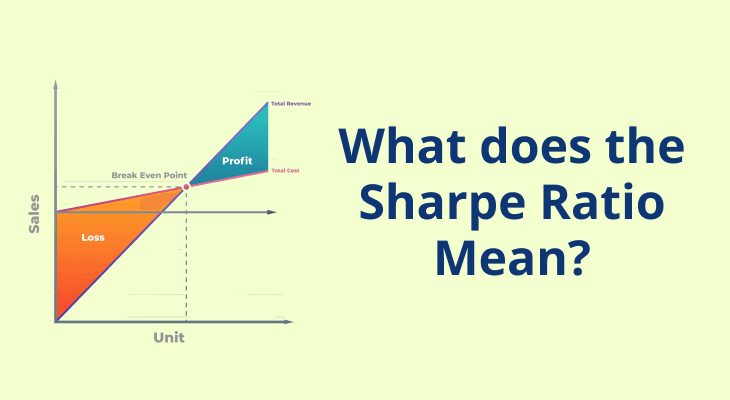
Table of content
What is a Decoding daily margin statement?
Daily Margin statement is an important document, sent by your broker, that gives you information about the available trading margin in your account on a particular trading day. The primary objective of a daily margin statement is to ensure that investors remain informed of the status of their margins at all times. This way, unfavourable situations like margin shortfalls and penalties for non-maintenance of adequate margins can be avoided. To help you understand the finer details of the daily equity margin statement, we’ve deconstructed a typical margin statement and explained the different terms commonly used in it.
Daily margin statement consists of two kinds of margin-related sections. The first is the fee levied by the stock exchanges as margin money for each trade. The other is relevant when you do not have sufficient funds to cover your trade value so you pledge stocks with your broker and avail a margin on the same.
Here’s an overview of each of these two types.
Margin Levied By The Stock Exchanges
According to SEBI, all stockbrokers are required to collect a margin from investors participating in the cash market on behalf of the stock exchanges. The margin thus collected has three components — Mark to Market (MTM) margin, Value at Risk (VaR) margin and Extreme Loss Margin (ELM).
This is done to ensure that all orders are settled seamlessly, without encountering any issues like a shortfall of funds. Investors who don’t maintain adequate margins may either be barred from entering into a trade or have their position prematurely liquidated.Margin offered by the stockbroker
Some stockbrokers like m.Stock offer Pay Later (MTF) where they lend you money against capital or margin in your trading account. In exchange, the purchased shares are pledged with the broker and investors have to pay interest on the borrowed capital. m.Stock charges one of the lowest MTF interest rates, starting @ 6.99%. MTF not only reduces your out-of-pocket costs but also helps you take on larger positions easily.
Why and how is the statement issued?
The financial markets and the stockbrokers, including other depository participants (DPs), are regulated by the Securities and Exchange Board of India (SEBI). Once you have understood how to answer the question, “What is a daily margin statement?”, it is important to note that SEBI has made it mandatory to provide investors with this statement. This means that stock brokers and other DPs, as a rule, must give investors these statements.
The issuance of margin statements is undertaken to inform brokers of their full responsibility and to avoid any forced margin shortfall or liquidity penalties from being imposed. SEBI has established regulations and guidelines concerning margin requirements, deciding the minimum amount of equity that must be maintained by investors in their margin accounts.
Daily margin statement requirements mandated by SEBI aim to safeguard investors’ interests, reduce the risks of margin trading, and maintain stability in the financial markets. Depository participants and stock brokers also generate margin statements to assure investors of entirely transparent transactions. Typically, the daily margin statement is delivered electronically to investors via email. It is protected by a password to ensure an additional layer of security. To access a daily margin statement, an investor is required to enter their PAN details.
The Daily Margin Statement Explained
Once you can answer the question, “What is a daily margin statement?”, you will be able to understand what a margin statement includes. It has various components, and the key parts of a daily margin statement are explained in the table below:
Name of Margin Statement Component (as shown in columns) | Explanation |
| Segment | The column titled “segment” informs you about the market segment and the clearing house/corporation. You can double-check these figures by categorising all your trades according to the clearing corporation or exchange. |
| Trade Day | This indicates the date on which you made a trade in the given segment. The margin daily statement is issued daily so this column will indicate that the trading date and the statement date are the same. |
| Days | The margin requirement remains valid unless the exchange settles the trade. This column gives you information about the status of the margin across three days of trading (T day - today’s trade, T+1 day - yesterday’s trade, and T+2 day - day before yesterday’s trade). |
| Funds | Funds reflect the balance that comes under the section “available to invest” on your dashboard. The data available is that which is represented till 5 pm only. Therefore, after-market trades are not accounted for here. If you click on the funds available, you will be able to view the break-up of figures. |
| Value of Securities after Cut | When a stock is sold from an investor’s Demat account, the Demat account is debited and shares are credited to a broker’s pool account. Exchanges settle trades on T+2 days so investors can receive the margin benefit on any shares that are held in the pool account. This section informs you about the value of the securities held in the pool account. |
| Total Margins Available | This is the total of Funds and Value of Securities after Cut. This reflects an amount that may be used by investors as a margin amount for BUY or SELL trades. |
| Total Upfront Margin (required) | This is a section that tells investors about the sum of the margin blocked upfront, for trades that are in the process of upcoming settlement (by the exchange). ELM (Extreme Loss Margin) and VaR (Value at Risk) are included in this section and you may click on the section to view the entire trade list. |
| Consolidated Crystallised Obligation | This is a section that displays the MTM margin requirement for every trade that is still to be settled by the exchange. |
| Total Margin Required | In this section, investors can view the entire upfront margin requirement (top row) and the MTM margin requirement (bottom row). |
| Excess/Shortfall | This is an important section of your daily margin statement as it shows investors whether they have used the entire margin available or if there is a need for the deposit of additional capital to avoid penalties. If the figure you see is positive, that means you have enough capital to use as a margin. A negative figure tells you that you are in the red and need more funds to be deposited. |
| Additional Margin as per RMS | This section tells investors about any additional margin that may be blocked by the DP or broker (just to be used as an extra surveillance margin). |
| Margin Status | As it states, this part tells you about the balance that is available to you for trading on the subsequent trading day. If you have a figure showing up in the negative, then you must deposit funds to trade the next day. |
| Penalty | In case you have not maintained the required balance, you may be charged a penalty. This column reflects whether a penalty has been charged and the amount thereof. |
Conclusion
After you have grasped how to read a daily margin statement, you may be ready to go ahead with your margin trading adventure. A daily margin statement aids you in understanding how margin trading works by breaking up the different components. While this helps you to make informed decisions, you may require some more education on margin trading to actually begin trading with ease. Nonetheless, the daily margin trading statement is a necessary means of informing traders about their trades and any requirements that must be fulfilled to undertake further trading.
FAQ
What is the daily margin requirement?
The daily margin requirement represents the minimum sum of money that must be maintained in any investor’s margin account. Typically, this is decided by the value of assets that are held by an investor and the amount of leverage that is used in trading on a margin.
What is the use of a daily margin statement?
A daily margin statement is provided by brokers to investors and acts as a report of a trader’s margin based on a specific trading date. The provision of this report is a mandatory requirement by the Securities and Exchange Board of India and reflects the transparency and compliance of the financial markets in India. It works in the investor’s interest as they get to know about their margin status and any shortfalls that are required to be filled.
How do you calculate daily margin?
You can calculate the daily margin in the equity segment. The daily margin for an equity share is the total of the Value at Risk (VaR) Margin and the Extreme Loss Margin (ELM). The estimated risk of loss in your investments is what the VaR reflects. You may also use an online margin calculator to compute the daily margin requirement for any market segment.


